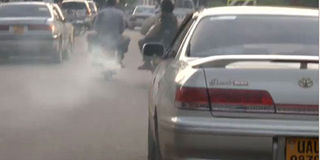Prime
Quality of Kampala air: A deathtrap

A motorcycle emits fumes on one of Kampala roads in a traffic jam. COURTESY PHOTOS
What you need to know:
- Close to 50,000 vehicles make their way to the city every day.
- This makes a total of more than 150,00 vehicles alone in the city, a day, that is spread across 189 square kilometres.
- The latest urban air quality database shows that 98 per cent of cities in low and middle income countries with more than 100,000 inhabitants do not meet WHO air quality guidelines.
Amanda Ngabirano lives in Bugolobi, a sprawling suburb barely 5km on the outskirts of the city. Every day, Ms Ngabirano cycles through Kampala’s congested streets to beat the jam and reach her workplace at Makerere University, where she teaches urban planning.
As a cycling devotee, her fascination with bicycles began in Netherlands, where she undertook her post-graduate studies.
“I want to move with ease so I think, normally this is the most convenient mode for me. It is very good for short distances; it’s very convenient. I don’t have to pay any money,” she says.
Air pollution in Uganda has reached worrying levels and exposes people to health risks, especially in Kampala. The number of respiratory tract infections in Kampala has soared in the recent past – a warning that air pollution is rapidly becoming a serious environmental threat.
Several studies have linked mounting respiratory tract infections such as asthma and chronic bronchitis to air pollution. The effects can be extremely serious. Research shows a connection between air pollution and lung cancer, and suggests it may contribute to childhood mortality.
Ms Ngabirano makes this trip to work every day amid the risks at the hands of Kampala’s careless motorists, with hope that her metabolism can cope.
“I am putting in some physical energy. I am working out and I think my metabolism is somehow enabled to cope with that kind of polluted environment. I wish I could cycle more from anywhere else because the pollution is too much here,” Ms Ngabirano says.
The World Health Organisation recommends cycling and walking to encourage exercising our bodies, which offers health benefits. But in at least one per cent of cities across the world, including Kampala, high levels of pollution have now rendered this recommendation inconsequential.
Cycling to work in certain highly polluted cities could be more dangerous to your health than not doing it at all, reads a study originally published in the journal, Preventive Medicine.
This study, carried out in more than 10 cities globally, shows that the level of toxins in the air causes harm to human health.
From the study, harm will occur to you depending on how long you spend either walking, jogging or even cycling on the road.
Kampala City tops the list for cities with the most polluted air in East, Central and Southern Africa. Here, 90 minutes of exposure to the fumes are enough to cause damage to your health.
Other cities in Africa include Bamenda in Cameroon, where 45 minutes on the road are enough to cause harm.
And, after 105 minutes in Kaduna, Nigeria, you are likely to catch complications from dangerous gases in the air.
Globally, 30 minutes of exposure to air in three cities – Gwalior and Allahabad in India plus Zabol in Iran – are just enough to cause harm.
According to statistics from the Uganda National Bureau of Statistics, close to 50,000 vehicles make their way to the city every day. This makes a total of more than 150,00 vehicles alone in the city, a day, that is spread across 189 square kilometres.
Many sources of urban outdoor air pollution such industries and vehicles are well beyond the control of individuals and demand action by cities, as well as national and international policy makers to promote cleaner transport, more efficient energy production and waste management.
The deputy executive director at the National Environment Management Authority (Nema), Ms Christine Echookit Akello, says there is not enough equipment in the country to help in this process.
“Air quality monitoring certainly requires equipment. We have some equipment in collaboration with Makerere University [but] it’s not adequate, we need to have more monitors all over the city so that we are able to see, for instance, what area is impacted more than the other,” Ms Akello says.
The latest urban air quality database shows that 98 per cent of cities in low and middle income countries with more than 100,000 inhabitants do not meet WHO air quality guidelines. Air quality is measured by the amount of particulate matter it contains. Dr Richard Lukandwa, a medical director at Norvik Hospital, says the particulate matter ranges from huge visible fumes to fine and invisible fumes.
“We have PM10, which looks at broadly what you would call the course particles or the big particles and those are a diameter of 2.5 micron to 10microns and then we have PM 2.5 which looks at the fine particles, the fine particles are from things like fog or smoke or the vehicle emissions,” Dr Lukandwa says.
According to Nema’s deputy, they have developed standards for air quality and different parameters are indicated for measurement. She says those standards are yet to be concluded but at least they are conclusive enough.
PM10 and PM2.5 include pollutants such as sulfate, nitrates and black carbon, which penetrate deep into the lungs and into the cardiovascular system, posing the greatest risks to human health.
Air pollution is one of the leading preventable causes of death in the world, killing nearly seven million people a year mostly in urban areas.
Indoor air pollution is responsible for roughly half those deaths.
Ambient air pollution, made of high concentrations of small and fine particulate matter, is the greatest environmental risk to health causing more than 3 million premature deaths worldwide every year.
Ms Akello says the pollution levels are worrying. “We are slowly poisoning ourselves, our lungs, our internal organs… as a country we must be concerned,” she says.
Research shows that exercising outdoors in several cities, including Kampala is actually worse for your health than doing nothing at all.
Health experts reveal that as urban air quality declines, the risk of stroke, heart disease, lung cancer, and chronic and acute respiratory diseases, including asthma, increases for the people, who live in them.
Dr Lukwanda says there is an increased incidence of diseases such as asthma. “We have chronic obstructive airway or emphysema, in some cases you may get lung cancer,” he says.
In 2014, a study conducted by scientists at the Department of Medicine at the Makerere University College of Health Sciences in collaboration with other foreign universities titled: “The state of ambient air quality in two Ugandan cities: A pilot cross-sectional spatial assessment” revealed grim findings.
It says Kampala City suburbs largely inhabited by the underclass such Nateete, Masaka Road, Rubaga, Mengo, Nansana and Najjanankumbi, sections of Entebbe Road, have the worst air quality, whereas leafy suburbs such as Naguru, Kololo, Kiwatule, Mbuya, Nakasero and Muyenga, have better air quality.
Conducted between June 30 and July 27, 2014, the study measured the concentration of particulate matter, one of the pollutants, in the air. Particulate matter refers to the microscopic solid or liquid matter suspended in the earth’s atmosphere. Dr Bruce Kirenga the lead investigator and Director Lung Institute Mulago hospital, reveals the dire consequences of inhaling this polluted air, which causes oxidative stress.
“At the end of the day, they disorganise the functioning of the cells. So, the cells behave abnormally, they develop cancer, the cells are damaged and when they heal they develop fibrosis,” he reveals.
More than half of the monitored cities in high-income countries and more than one-third in low- and middle-income countries reduced their air pollution levels by more than 5 per cent in five years.

A factory releases fumes in one of the industrial areas in Kamapala.
In East Africa, Kenya, Tanzania and Rwanda tightened the noose on importation of used cars. More taxes are levied on second hand vehicles and electronics. This was done to avoid dumping and its effects, especially air pollution.
Ministers from the East African states made the decision to have the harmonised depreciation rates starting July 1, 2015 but the decision was delayed and was effected from September.
The depreciation rating for Kenya provides up to a maximum of 70 per cent for eight years from the date of the first registration of the used motor vehicle. In Tanzania, the rating provides up to 80 per cent with no limit on the number of years.
Rwanda initially used the previously accepted customs value and Internet sources to determine customs values for used motor vehicles.
Uganda too previously used a reference value guideline derived from the average market prices of used motor vehicles from Internet sources, adjusted with freight and insurance costs to determine the customs value.
Figures from the Real Time Air Quality Index for Uganda measured on a 24-hour basis shows that air in Kampala oscillates between 70 for moderate to over 162, which is beyond unhealthy for breathing.
Dr Lukandwa explains that at 0 to 50, it’s considered good; at 50 to 100, it’s considered moderate; 100 to 150 is hazardous but mainly to the most at risk population like asthmatics; above 150 to 200, it is hazardous to the general population.
From the data, it is noted that air in Kampala is very harmful for human health for the greater part of the morning from around 6am to midday. It then falls up to 69 and later in the evening it hits the peak again.
According to a survey conducted by Makerere University College of Health Sciences, 40 per cent of deaths in Uganda are due to non-communicable diseases such as cardiovascular diseases, cancers, diabetes and chronic lung diseases. Yet if there is a malady lurking in the backyard, it’s the air we are breathing, an invisible death-trap that continues to afflict the health of thousands.
Ranking. Kampala City tops the list for cities with the most polluted air in East, Central and Southern Africa. Here, 90 minutes of exposure to the fumes are enough to cause damage to your health. Other cities in Africa include Bamenda in Cameroon where 45 minutes on the road are enough to cause harm.
Numbers.
According to statistics from the Uganda National Bureau of Statistics, close to 50,000 vehicles make their way to the city every day. This makes a total of more than 150,00 vehicles alone in the city, a day, that is spread across 189 square kilometres.
Data.
The latest urban air quality database shows that 98 per cent of cities in low and middle income countries with more than 100,000 inhabitants do not meet WHO air quality guidelines.




